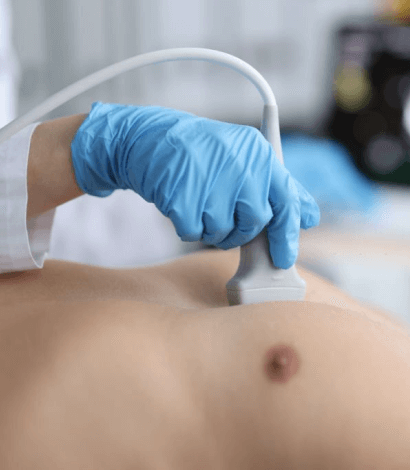Invasive Cardiology
Invasive and interventional cardiology uses minimally-invasive testing and procedures to diagnose and treat heart conditions. At Cardiovascular Medicine, PLLC, we are leaders in providing invasive cardiology treatments that relieve your symptoms and lower your risk of complications from heart disease. Our board certified physicians have undergone extensive specialized training to ensure you receive state-of-the-art care.
When to See an Interventional Cardiologist
Having a heart condition can prevent you from living life to its fullest. Interventional cardiologists can help you experience relief from your symptoms as well as reduce your risk of developing a more serious form of heart disease. Invasive cardiology procedures can help manage various heart conditions, including:

Diagnostic Testing
To understand what’s causing your symptoms, it is necessary to perform diagnostic testing. We offer several types of diagnostic procedures that allow us to see how well your heart and vessels are functioning. This provides us with a clearer picture so we can recommend the appropriate treatment plan. Our comprehensive diagnostic procedures include:
Cardiovascular Treatments
The goal of treatment for cardiovascular conditions is to provide you with both relief from symptoms and the peace of mind that comes with prioritizing your health. We are proud to offer the most advanced treatment options in the area. With the right interventional cardiology treatments, we can help you better manage your condition and significantly improve your day-to-day living. Our treatments include:
Angiography of Non-Cardiac Vessels
Angiography for Non-Cardiac Vessels
Angiography is a medical imaging technique that allows us to see the inside of arteries, veins, and the heart, allowing us to diagnose blockages and problems with blood flow. Though angiography is commonly thought of as a diagnostic tool for the heart, we also use it to show the functioning of veins and arteries in non-cardiac vessels. The two types of non-cardiac angiograms we use are:
Renal angiography
Renal angiography can help us understand if any issues you are experiencing, such as high blood pressure, could be because of a kidney problem. We also use renal angiography if we suspect problems with the arteries in your kidneys, including narrowing, bulging (aneurysm), blockage, and blood clots.
Peripheral angiography
Peripheral arteries move blood away from your heart and toward your extremities. They are essential in healthy circulation. If we suspect issues with your peripheral arteries that could be causing circulation issues, we will recommend a peripheral angiography.
What to Expect
To prepare for an angiography, you will need to fast prior to the procedure, either for several hours before the test or overnight. We will discuss any current medications you are taking and may ask you to stop taking certain prescriptions, such as blood-thinning medications. An angiography for non-cardiac vessels should take about 30-40 minutes. The process for both renal angiography and peripheral angiography follows the same basic steps:
- You will lay on a procedure table. We will administer sedation at this point if needed.
- We'll use numbing medication at the site of the catheter injection, either your groin or your arm. We'll also prep the area to ensure it's clean and sterile.
- Using a needle, we will insert a thin wire into a large artery in the groin area or near your arm. This wire guides a thin tube called a catheter.
- Once the catheter is in place, we inject contrast dye through the catheter and take X-rays of the arteries
After the Procedure
After the angiography, you will be taken to the recovery room, where nurses can observe your vitals and the injection site. You will need to lay flat and keep your arm or leg straight for several hours after the test. It's important to drink plenty of water to help flush the contrast dye from your body.
After the test, you will be able to go home later that day and will need to have someone drive you home. You should be able to resume moderate activity 24-48 hours after the test. Avoid strenuous activity or heavy lifting for a week.
Risks & Side Effects
X-ray procedures do pose a small amount of risk. This is due to the exposure to radiation. Though the exposure is minimal, your personal risk will depend on how many X-rays you’ve had in the past. We don’t recommend the test for those who are pregnant. Talk to your doctor about any concerns you have with X-ray.
Am I a Candidate?
If you have symptoms that could indicate peripheral or renal artery problems, or if you have risk factors, our interventional cardiologists will be able to determine if you qualify for screening. There are certain risk factors that put you at higher risk for developing issues with blood flow and circulation. They include:
- Smoking
- High blood pressure
- Atherosclerosis
- Diabetes
- High cholesterol
- Being 60 years or older
More on Angiography of Non-Cardiac Vessels
Angiography for Kidney Issues
Your kidneys filter waste products and remove excess fluids. Adequate blood flow is essential for your kidneys to work properly. When blood flow is reduced, it could lead to kidney tissue damage and increased blood pressure. Contrast dye helps us better see the blood flow and identify potential issues.
Symptoms of a potential issue with the arteries in your kidneys:
- High blood pressure
- Elevated protein levels in the urine
- Swelling in your body's tissues
Symptoms of Peripheral Arterial Disease
- Wounds or sores on the leg, foot, and toes that won't heal
- Coldness in the lower leg or foot compared to the other leg
- Slow toenail or leg hair growth
- Erectile dysfunction
- Leg numbness or weakness
- No pulse or a weak pulse in the legs or feet
- Shiny skin or skin color changes on the legs
Possible Complications
Complications, though rare, can arise from a renal angiography or peripheral angiography, including:
- Bleeding
- Infection
- Nerve injury
- Blood clot
- Swelling caused by a collection of blood (hematoma)
- Damage to an artery or an artery wall
- Kidney failure from the contrast dye
- Allergic reaction to the contrast dye
Meet Your Illinois and Iowa
Cardiovascular Physicians
CVM Locations
Insurance Providers We Accept
In Search of Care? Request a Consultation Today



